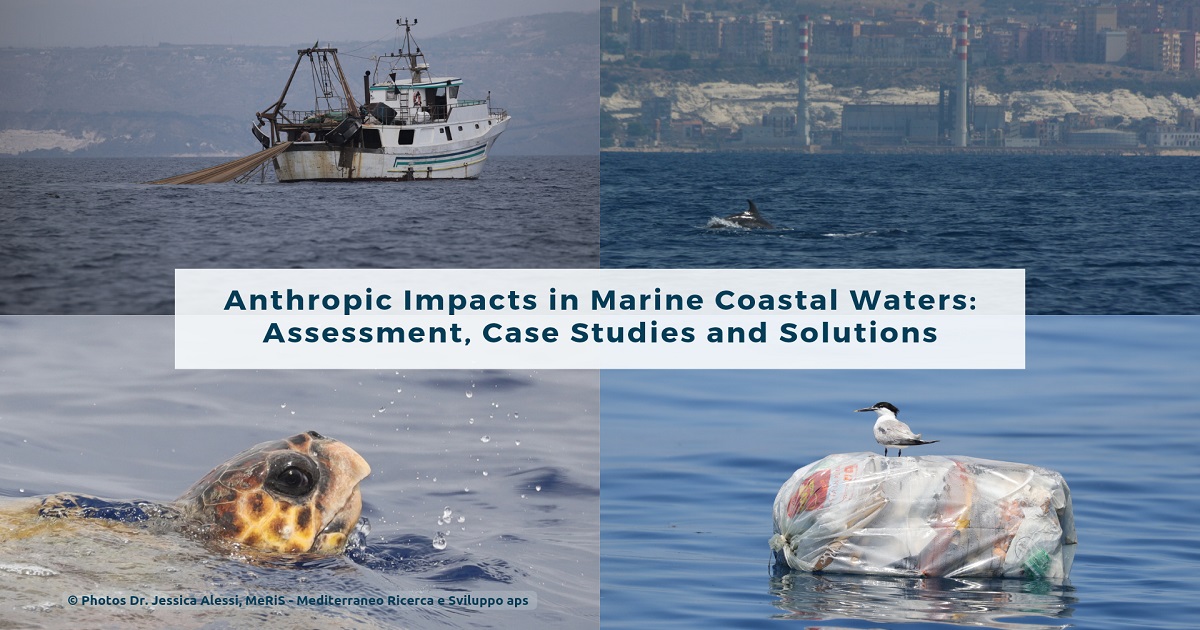Topic Menu
► Topic MenuTopic Editors

2. MeRiS—Mediterraneo Ricerca e Sviluppo APS, 92026 Favara, Italy

Anthropogenic Impacts in Marine Coastal Waters: Assessment, Case Studies and Solutions

Image courtesy of ©Dr. Jessica Alessi, MeRiS - Mediterraneo Ricerca e Sviluppo APS
Topic Information
Dear Colleagues,
Chemical pollutants, heavy metals, and macro- and microplastics are continuously discharged from the mainland into the sea and are bio-accumulated and bio-magnified by marine organisms, with negative consequences on the whole trophic web, at all ecosystem levels. Manmade underwater noises create disturbance to intraspecific communications, from fish to cetaceans, even producing malformations in invertebrate larvae, while both commercial and recreational maritime traffic represent a danger for collisions with cetaceans. Fishing activities interact at multiple levels, modifying the trophic chain and the flows of biomass (and energy) across the ecosystem, altering habitats and benthic communities. Finally, poorly managed large-scale mariculture can damage coastal wetlands and nearshore ecosystems.
In recent years, the evaluation and monitoring of all these anthropogenic impacts on the coastal environment have been the subject of in-depth studies. Now the most pressing needs concern the development of conservation measures, proposed and carried out at a regional level, as expression of broader plans involving not only researchers but also government and non-government organizations, industry, and local communities. In short words, effective marine conservation requires collaboration and a multidisciplinary approach.
This Topic aims to highlight the recent knowledge on the impact of human activities on marine fauna and coastal environments as well as on habitat management and environmental conservation plans. The Topic Editors kindly invite you to submit a manuscript focused on any of the above topics. Assessment of pollution levels and impact on marine organisms and their habitats, possible solutions, and management measures, are welcome as case studies (original papers) or reviews.
Prof. Dr. Alberta Mandich
Dr. Jessica Alessi
Topic Editors
Keywords
- coastal environment
- marine fauna
- anthropic impacts
- chemical pollution
- marine litter
- noise pollution
- fisheries
- mariculture
- impact assessment
- habitat conservation
Participating Journals
| Journal Name | Impact Factor | CiteScore | Launched Year | First Decision (median) | APC |
|---|---|---|---|---|---|

Animals
|
2.7 | 5.2 | 2011 | 17.7 Days | CHF 2400 |

Coasts
|
- | - | 2021 | 31.2 Days | CHF 1000 |

Diversity
|
2.1 | 4.0 | 2009 | 17.1 Days | CHF 2100 |

Journal of Marine Science and Engineering
|
2.8 | 5.0 | 2013 | 15.6 Days | CHF 2600 |

Sustainability
|
3.3 | 7.7 | 2009 | 19.3 Days | CHF 2400 |

Oceans
|
1.6 | 3.5 | 2020 | 38.6 Days | CHF 1600 |

Earth
|
3.4 | 5.9 | 2020 | 19.4 Days | CHF 1400 |

Water
|
3.0 | 6.0 | 2009 | 19.1 Days | CHF 2600 |

Preprints.org is a multidisciplinary platform offering a preprint service designed to facilitate the early sharing of your research. It supports and empowers your research journey from the very beginning.
MDPI Topics is collaborating with Preprints.org and has established a direct connection between MDPI journals and the platform. Authors are encouraged to take advantage of this opportunity by posting their preprints at Preprints.org prior to publication:
- Share your research immediately: disseminate your ideas prior to publication and establish priority for your work.
- Safeguard your intellectual contribution: Protect your ideas with a time-stamped preprint that serves as proof of your research timeline.
- Boost visibility and impact: Increase the reach and influence of your research by making it accessible to a global audience.
- Gain early feedback: Receive valuable input and insights from peers before submitting to a journal.
- Ensure broad indexing: Web of Science (Preprint Citation Index), Google Scholar, Crossref, SHARE, PrePubMed, Scilit and Europe PMC.

